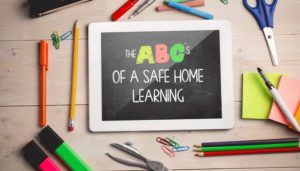We get it. We’re parents too and this is not the school year beginning any of us envisioned for our children. Parents and guardians would much rather be rummaging ransacked shopping aisles for that last available three-ring binder than negotiating complex schooling decisions affecting our kids against this ever-shifting landscape. One thing is certain amidst all the unknowns and each family’s unique circumstances: we are committed to our children’s mental, socio-emotional, and physical well-being.
And that’s why it’s critical parents and caregivers do their homework to ensure safe online learning environments for their kids.
Here are some tips for navigating virtual schooling and increased technology use in your home #BackToSchool Click To TweetTechnology brings many gifts, but also comes with serious risks of which parents must be aware: particularly the high potential of exposure to harmful sexually explicit material and even predators. The FBI issued a warning during the first wave of school closures advising parents and caregivers to be vigilant for online sexual exploitation. The National Center on Missing and Exploited Children saw a 93% increase in reports of online enticement of children by predators over the first half of 2020 as compared to January – June of the previous year. We know that predators have openly shared strategies online about grooming children for sexual abuse and exploitation during COVID-19.
However, predators aren’t the only online threat. Unfortunately, sexually exploitative material—including hardcore pornography—is all too-easily accessible by children, especially when Internet filters and device controls are nonexistent or inadequate at home or at school. Exposure to pornography and sexually explicit material threatens young children’s and adolescents’ well-being and is antithetical to a safe, healthy, and productive learning environment. Scientific research provides extensive evidence on the harms of pornography, showing that children are at even greater risk as exposure affects their developing brains and shapes their sexual templates. The younger and more often children are exposed to such content the more problematic it becomes, introducing children to behaviors they may eventually acquire themselves – even leading to child-on-child sexual abuse. Adolescents are more susceptible to forming addictions than adults because the dopamine receptors in their nucleus accumbens (i.e. the brain’s pleasure center) are much more active and have an exaggerated plasticity in response to stimuli. Internet pornography consumption by adolescents has been associated with risky sexual behavior and adverse mental health effects such as to depression, anxiety, low self-esteem, agression (in males), and difficulty concentrating.
To support overburdened families during this unprecedented, vastly virtual school year start, we’ve compiled the ABC’s of creating a safe online home learning environment to protect the children in your life – during the pandemic and once it’s (hopefully soon) over.
ABC's of creating safe online home learning: Awareness, Boundaries, Communication #BackToSchool Click To TweetA – Awareness
B – Boundaries
C – Communication
A – Awareness
Awareness of online risks and how to mitigate threats to your child’s safety and well-being needs to be every parent’s priority. Ask school administrators and teachers what – if any – safety measures are in place to protect students from access to harmful material during virtual learning. Know and familiarize yourself with the research databases and platforms they’ll be using (many popular school databases like EBSCO include pornographic images and sexually explicit content that bypass school filters. Some teachers are using TikTok or Instagram to get their classes communicating, but these platforms are full of sexual predators and sexual content.). Be sure to obtain your child’s logins and passwords, consistently check what they’re working on, and periodically review their search histories.
Educate yourselves about the apps, games, and social media platforms popular with your child and his or her peers. Do your research on apps by conducting reviews by third-party experts (like here or here). Don’t trust the description given by the platforms themselves or the GooglePlay and AppleStore app ratings, as they do not adequately expose the very serious risks. Consider creating an account yourself to test it out and connect with your child’s account if you deem an app appropriate for their use. Monitor their activity, who they’re interacting with, and who is reaching out to them. Ask your child questions and let them know you will be involved and aware of their online life, just as you are in their non-virtual one.
I'm committing to be as involved in my children's online life as I am in their non-virtual life #BackToSchool Click To TweetResources:
- Learn more about protecting your children online here
- Our partner organizations, Protect Young Eyes, has easy-to-follow, step-by-step instructions to turn on controls and safety features on devices and popular apps
- Protect Young Eyes is also hosting a webinar series, The Tech Ready Parent; these 30 minute webinars on topics ranging from online risks and safety tips to specific apps
- Skimming blogs and following social media from Protect Young Minds, Educate and Empower Kids, ParentsAware.info, and Fight the New Drug are great tools, too!

B – Boundaries
Boundaries are essential to keeping kids safe online. We’re talking about literal boundaries (filters, parental controls, privacy settings, rules) to keep harmful content and people away from your child, as well as personal boundaries within a virtual world.
Whether your children are using their own or school-issued digital devices (Chromebooks, iPads, laptops), it’s paramount that parental controls are activated on the devices and search engines (Google Chrome, Safari, etc). Make sure you have adequate Internet filters at home to further block exposure access to pornographic or sexually explicit materials and websites. Remember, most school-issued devices are placed in your children’s hands (or shipped to your home)with no safeguards in place. NCOSE has been pressuring Google to turn on parental controls on the highly problematic Chromebooks they know are being distributed to students. And while Google’s responded to our advocacy efforts to more thoroughly filter Google images, scientific terms like “sex” still result in pornographic images that link to hardcore porn and YouTube continues to eroticize children and is used for pedophile networking. So for the time being at least, it’s up to families to ensure the proper controls and filters are in place (see below for some great resources on how to do this).
It’s also paramount you and your child determine online/screentime boundaries that align with your family’s values and priorities. This can mean setting limits on screentime, designating off-limit areas for device use (e.g. bedrooms), what type of information shouldn’t be shared online, even whether or not your children are okay with you posting their pictures on Facebook or Instagram. No matter what boundaries your family sets, clearly stating them and even having them in writing will lead to a healthier, safer online environment.
Clear boundaries will lead to a healthier, safer online environment #BackToSchool Click To TweetResources
- Our five favorite Internet filtering services for families
- Turn on SafeSearch for Google Chrome and YouTube
- Create a contract or pledge with your kids on how they will use media. Here’s a sample you can use in English and in Spanish.
C – Communication
Consistent, open communication with your children is key to keeping them safe while they’re learning, playing, and socializing online. Use age appropriate language to explain the risks of Internet usage and let them know your primary concerns. Teach them to recognize pornography and predatory behavior from strangers (and even known adults) and develop a clear set of actions they should take – including immediately telling you, a teacher, or another trusted adult. Kids are more likely to help protect themselves if they understand what they need to watch out for, can name it, and know what to do when confronted. Need help talking to your family about difficult topics like pornography? Read our blog here for some helpful tips.
Consistent, open communication with children is key to keeping them safe while they're learning, playing, and socializing online. #BackToSchool Click To TweetResources:
- Talk Today, Safer Tomorrow: 10 easy conversation starters to talk to your children about pornography created by the Safeguard Alliance, a project of NCOSE
- Our partner Protect Young Minds has a wealth of resources for free and for purchase (books, conversation starters, and videos) to guide you in conversations with your kids about pornography, body safety, and internet safety.
- Great books from Educate and Empower Kids to keep the conversation going!
Remember your ABCs: If you’re Aware of online risks, set Boundaries, and Communicate consistently with your kids, you’ll surely be top of the class when it comes to promoting a safe online learning environment at home.
Stay tuned for more resources over the next month!
*The National Center on Sexual Exploitation’s 2020 Back to School(ing) Campaign aims to equip families and educators with information, resources, and actions they can take to keep kids safe online as vast numbers of students start the school year in a virtual learning environment. Over the four week campaign, we’ll feature the people, organizations, and entities that can have the greatest impact ensuring a safe online learning environment, specifically: families, school administrators, corporations, and the US federal government. This is Part 1 of 4: Families*




